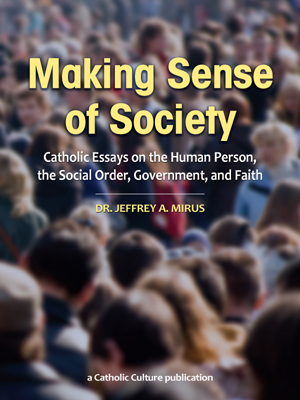Follow the Science
By Fr. Jerry Pokorsky ( bio - articles - email ) | Sep 20, 2021
“Everyone knows” that Catholics are superstitious. We believe that the Incarnation reconciles God and man, and nature and grace. Faith and reason, and religion and science, are perfectly compatible. Imagine that. So let’s take a break from our “superstitions” and follow the science.
Here are some notes using Mayo Clinic staff reports on the development of an unborn baby.
During the first two weeks of the mother's cycle, the journey of the sperm to seek an ovum for conception takes place. During the third week, when an ovum is at last released from the woman's ovary, sperm and egg unite, and fertilization occurs, forming a one-celled entity with the DNA of a new human being. Baby (called in biology a zygote to denote its location) has 46 chromosomes — 23 from Mom and 23 from Dad. These chromosomes determine the baby's sex and physical traits. This form of replication at conception—meiosis — is unique in biology. All other cell replications reproduce with the 46 chromosomes intact and the same in the new cells (mitosis). So, the conceived baby is a separate entity of the same species but is not biologically identical to either parent.
Immediately, this one-celled organism begins to develop; every cell formation carries the information about the sex of the baby in its chromosome code. Baby travels down the fallopian tube and begins dividing to form a cluster of cells resembling a tiny raspberry. The rapidly dividing ball of cells burrows into the interior walls of the mother's uterus in a process called implantation. The term "embryo" denotes its change of location, but the entity is the same: a human baby.
By the fifth week, the mother may become aware that she is pregnant. Baby has developed three layers. The top layer will give rise to the baby’s outermost layer of skin, nervous systems, eyes, and inner ears. The baby's heart and a primitive circulatory system will form in the middle layer of cells. This layer of cells will also serve as the foundation for the baby's bones, ligaments, kidneys, and much of the reproductive system. The inner layer of cells is where the baby's lungs and intestines will develop.
Growth is rapid during the sixth week. The baby's brain and spinal cord begin to form. The heart and other organs also are starting to take shape. Structures necessary to the formation of the eyes and ears develop. Tiny buds appear that will soon become arms. Baby Embryo’s heartbeat may first be detected by ultrasound as early as 5 1/2 to 6 weeks.
Seven weeks into the pregnancy, the baby's brain, and face grow. Depressions that will become nostrils become visible, and the beginnings of the retinas form. Lower limb buds that will become legs appear, and the arm buds that sprouted last week now take on the shape of paddles. By the eighth week, fingers have begun to form. The baby's ears also take shape and, the eyes become well-defined. The upper lip and nose have formed. The baby might measure about half the diameter of a US quarter.
In the ninth week, the baby's arms grow, and elbows appear. Toes are visible, and eyelids form. The baby's head is large but still has a poorly-formed chin. The unborn baby’s length is the diameter of a U.S. penny. By the tenth week, the unborn baby's head has become more round. The baby can now bend his elbows.
By the eleventh week, the baby's face is broad, the eyes widely separated, the eyelids fused, and the ears low set. Buds for future teeth appear. Red blood cells are beginning to form in the baby's liver. By now, the baby might measure about 2 inches the length.
The twelfth week sees the unborn baby sprouting fingernails and the tiny beginnings of reproductive organs. (If the baby is a girl, every ovum she will produce in life will develop as her ovaries develop through the 20th week.) The baby's face now has taken on a more developed profile. His intestines are in the abdomen. By now, the baby might be about 2 1/2 inches long and weighs about 1/2 ounce (sic!).
Week 16. The baby's eyes move. The baby might be more than 4 1/2 inches. Week 17: The baby’s heart is pumping about 100 pints of blood each day. Week 18: The baby begins to hear. The baby's digestive system has started working, and he may measure 5 1/2 inches and weigh 7 ounces. Week 20: At the halfway point, the baby is just over 6 inches in length. Its movements begin to be felt by the mother (quickening). It is regularly sleeping and waking. The actions of mom may awaken the little thing.
Week 21. The baby can suck its thumb. Week 23: Fingerprints and footprints form, and the little rascal begins hiccupping, causing jerking movements. The baby might be about 8 inches in length. Week 25: The baby responds to the voice of his mom. (GPS units in cars often use a female voice because a baby in the womb first hears the soothing voice of its mother.)
Week 28 – 33: Baby's eyes partially open; his hair grows; his rapid weight gain begins; his eyes detect light, and pupils can change size in response to a stimulus. The baby has no room to punch, but he stretches and rolls, and wiggles. After thirty weeks, a mother often feels like a beached whale. (That’s not in the Mayo reports. That comes from the testimonies of mothers.)
Week 40. The baby is fully formed and ready to be birthed. Sometimes unborn babies are reluctant to enter the world because they’ve got a good thing going with mom. Sorry, kid. We need you to pay off that federal debt. (Not in the Mayo report, either, but Catholic superstitions include the belief that 2 + 2 = 4.)
Unborn babies – every unborn baby regardless of heritage, regardless of physical or mental characteristics – need our protection and love. And we need them to fill the earth according to God’s plan of marriage. We rejoice in science, the study of God's handiwork. Life is beautiful, and God is great. Denying the humanity of an unborn baby and insisting we can choose our gender identities are anti-scientific superstitions.
“And he took a child, and put him in the midst of them; and taking him in his arms, he said to them, ‘Whoever receives one such child in my name receives me; and whoever receives me, receives not me but him who sent me.’” (Mk 9:36-37)
All comments are moderated. To lighten our editing burden, only current donors are allowed to Sound Off. If you are a current donor, log in to see the comment form; otherwise please support our work, and Sound Off!








